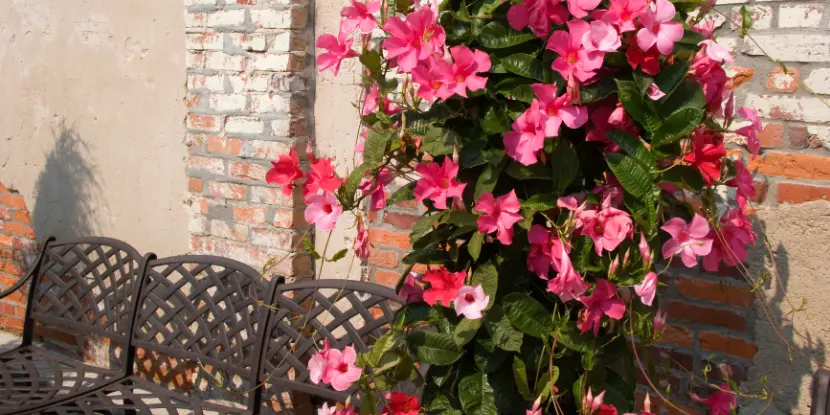Mandevilla is a flowering vine native to Central and South America. Its dazzling, trumpet-shaped flowers and glossy green foliage make it a favorite for gardens, landscapes, and containers.
The plant flourishes in Southern California’s benign climate, showing vibrant blooms from spring to fall. Some hybrid varieties can produce flowers up to 5 inches in diameter; colors include bright red, pink, white, crimson, yellow, and bi-colored.
Mandevilla Varieties
Heat-tolerant and water-efficient, mandevilla is a show stopper with its lustrous dark green leaves and large, electric, funnel-shaped flowers.
- Alice DuPont is the most recognized and widely planted mandevilla variety. Robustly vining, it will wrap around anything for support. The brilliant bloom has the truest pink color of all mandevilla. It does best when planted by a fence, trellis, or arbor, or wired to a solid wall for support. Very fast-growing in the heat of summer, it needs plenty of room to sprawl.
- White and yellow mandevillas resemble Alice DuPont in growth habit and form. The main difference is the flower color. The white form has an elegant yellow throat, giving way to the purest white peals, while the yellow is almost neon yellow throughout.
- Red Riding Hood Mandevilla has been alternately called Dipladenia. This plant resembles Alice DuPont, but grows as a shrubby vine and doesn’t trail readily. The leaves are quite small comparatively, as are the blossoms. They possess the same bright pink color as Alice DuPont, but with a bright yellow throat. Red Riding Hood performs well in low pots, where it can be trained into a bush, or planted in hanging baskets where it billows over the edges and provides spectacular summer color.
- Botanically known as Pyrostegia Grandiflora, Orchid Swirlis is a sprawling shrub that resists training. Give it plenty of room, and you’ll be rewarded with the most delicately swirled orchid-lavender blooms supported by hardy stems.
- Sun Parasol is another variety that excels in California’s climate. It’s known for its vigorous growth and adaptability. The Sun Parasol series features various colors, including deep reds, bright pinks, and crisp whites. Its blooms stand out with a velvety texture and vibrant colors, often attracting hummingbirds and butterflies to the garden. This variety is particularly resistant to pests and diseases.

Blooming pink mandevilla on a trellis.
Growing Conditions for Mandevilla
Sun & Soil
Mandevillas are well-suited for USDA Hardiness Zones 9 to 11 and require well-drained soil. They prefer a location with full sun to partial shade. They thrive with morning sunlight and some protection from harsh afternoon rays, particularly in hotter climates.
A soil pH between 6.0 and 7.5 is ideal for root development and vigorous blooms. Mandevilla vines love rich, well-draining soil that retains moisture without becoming soggy.
A mix of loamy soil, peat, and perlite or sand ensures proper drainage and aeration around the roots.
Temperature
Mandevilla vines are sensitive to cold. They prosper in the 60°F to 85°F temperature range (15°C to 29°C). Temperatures below 50°F (10°C) can damage or kill them.
In areas where temperatures drop below this range, it’s crucial to cover mandevilla plants or bring them indoors to protect them from frost. Using frost cloths or moving potted mandevillas to a greenhouse or indoors near a sunny window can ensure they survive the colder months.
Planting Mandevilla
- Choose a sunny, raised area, applying plenty of planting or soil mix to raise the bed’s level.
- Amend the soil with organic matter or a balanced, slow-release fertilizer to promote healthy, lush foliage and abundant flowers.
- Dig a hole 1.5 to 2 times wider than the root size, but no deeper than the original pot.
- Rest the root system on the undisturbed soil at the bottom, and fill around the roots with your prepared bed mixture.
- Water your new plant with a root stimulator, following the directions on the label.
- If you’re using a trellis, install it no more than 12 inches away from the plant, so it’s readily available for support.
- Regularly check the soil’s pH, aiming for a slightly acidic to neutral range.

Potting a young Mandevilla plant.
Watering Mandevilla
Most mandevillas have enlarged root systems that hold water for sustenance during prolonged dry periods. These amazing vines are the camels of the plant world!
The best approach is to water mandevilla plants deeply but infrequently, allowing the top inch of soil to dry before watering again. This encourages root growth and enhances the plant’s drought tolerance.
Increase the watering frequency during the hotter, dryer months, but ensure the soil has adequate drainage to prevent root rot. A good rule of thumb is to water once a week during the growing season, adjusting as necessary based on rainfall and temperature.
A drip irrigation system or soaker hose can directly target the plant’s roots and minimize water waste.
Fertilizing Mandevilla
Use a well-balanced, slow-release fertilizer that promotes blooming. An ideal formulation is a 10-20-10 or 20-20-20 mixture, applied every two weeks during the growing season.
Begin fertilizing in early spring, as new growth appears, and continue through the end of summer.
During winter, reduce fertilization to once a month or cease entirely as growth slows. Always water thoroughly after applying fertilizer to help distribute the nutrients through the soil and prevent root burn.
For potted mandevillas, consider a liquid fertilizer at half the recommended strength for more controlled feeding.

Red mandevilla growing in pots.
Insects & Diseases
Mandevilla plants, while hardy, aren’t immune to pests and diseases. Below are common issues and natural control methods to keep your plants healthy:
Pests
- Spider Mites: These tiny pests cause leaf discoloration and stippling. Rinse plants with water to dislodge them, or use neem oil as an organic pesticide.
- Mealybugs: These white, fluffy pests suck plant sap, weakening the vine. Remove them by dabbing with alcohol-soaked cotton swabs or applying insecticidal soap.
- Aphids: Small and typically green, aphids feed on plant sap. Spray with water to knock them off or introduce natural predators like ladybugs.
Diseases
- Powdery Mildew: A fungal disease that appears as white, powdery spots on leaves. Increase air circulation and apply a mixture of water and baking soda as a preventive measure.
- Root Rot: Caused by overly moist soil conditions. Ensure good drainage and avoid overwatering. You may have to remove infected plants to prevent spread.
- Botrytis Blight: This fungus causes gray mold on flowers and leaves. Improve air circulation and keep foliage dry. Prune infected parts and apply a copper fungicide if necessary.
Propagating Mandevilla
Stem Cuttings
- Choose a healthy, non-flowering stem, about 4-6 inches long.
- Cut just below a leaf node using a clean, sharp knife or scissors.
- Strip the leaves from the lower half of the cutting.
- Dip the cut end into rooting hormone powder or gel.
- Plant the cutting in a pot filled with a well-draining potting mix, such as half peat and half perlite.
- Water lightly and cover the pot with a plastic bag, or place it inside a propagator to maintain humidity.
- Place in indirect light and ensure the temperature remains around 70°F (21°C).
- Roots typically develop within 3-4 weeks. Check for resistance when slightly tugged, indicating root growth.
Layering
- Identify a long, flexible stem that can be bent to the ground.
- Choose a stem section with a leaf node, and remove the leaves around this area.
- Make a small, shallow cut on the underside of the stem at the node to encourage rooting.
- Bend the stem to the ground and secure it using a U-shaped pin or heavy stone.
- Cover the wounded section and node with soil, ensuring it stays moist.
- Roots will develop at the node after a few weeks. Once established, sever the new plant from the parent and transplant it.

Flower of the Brazilian Jasmine or Dipladenia.
Containers & Winter Protection
Container growing enables easy movement to optimize sunlight exposure and protect the plants from less-than-ideal weather conditions. It also lets you create micro-environments tailored to the plant’s needs.
Before the first frost, move your potted mandevillas indoors to a well-lit area with temperatures above 50°F (10°C). Reduce watering during winter, keeping the soil slightly moist but not saturated.
Trimming back the vine encourages a bushier plant in the spring. For plants in milder climates where outdoor wintering is possible, elevate the container from direct contact with the ground to prevent freezing. Consider wrapping the pot in bubble wrap or burlap to insulate the roots.
FAQs: Mandevilla Care
Q: How often should I water my mandevilla plant?
Water deeply but infrequently, allowing the top inch of soil to dry before the next watering. Typically, watering once a week during the growing season is enough.
Q: What’s the best fertilizer for mandevilla plants?
A well-balanced, slow-release fertilizer with a formulation of 10-20-10 or 20-20-20 is ideal for mandevilla plants. Apply every two weeks during the growing season, from early spring through the end of summer.
Q: How do I protect my mandevilla from pests?
For common pests like spider mites, mealybugs, and aphids, rinse plants with water or use organic options like neem oil and insecticidal soap. Regular inspections help catch infestations early.
Q: Can mandevilla plants survive winter outdoors?
Plants should be brought indoors or protected in colder climates. If they must stay outdoors, insulate the container and elevate it from direct ground contact to prevent freezing.
Q: How can I propagate my mandevilla plant?
Mandevilla can be propagated through stem cuttings or layering. Both methods involve preparing a part of the plant to develop roots independently, eventually allowing it to grow separately.
Q: How can I control diseases affecting my mandevilla?
Ensure good air circulation and avoid overwatering. A baking soda mixture or copper fungicide can help with diseases like powdery mildew and blight.
Q: What kind of soil is best for mandevilla plants?
A well-draining potting mix with a slightly acidic to neutral pH is best.
Q: Is it necessary to prune mandevilla plants?
Pruning isn’t strictly necessary, but it can encourage bushier growth and remove any unhealthy or dead parts of the plant to promote overall health.
Q: How much sunlight does a mandevilla plant need?
Mandevilla plants thrive in full sun to partial shade. They should receive at least 6-8 hours of sunlight daily for optimal growth and blooming.

